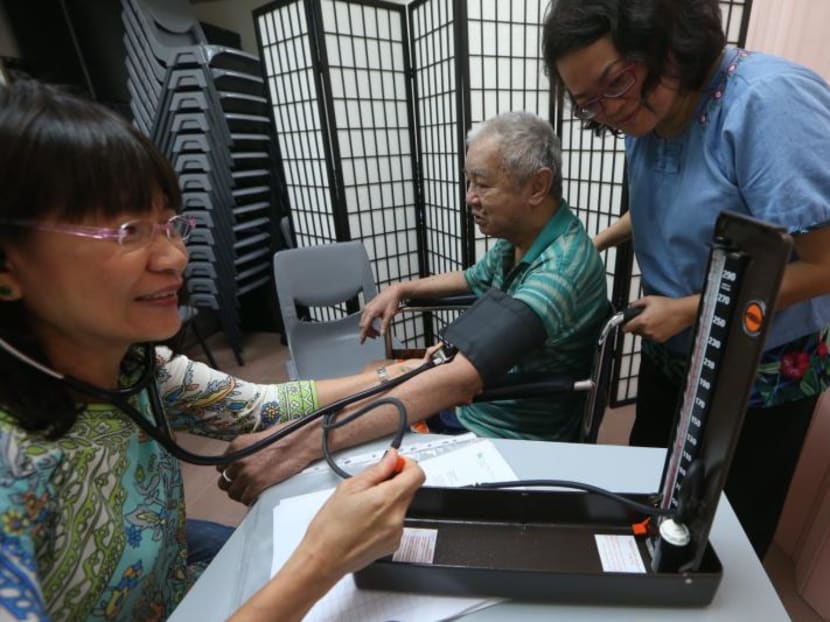Why it is so hard to curb hypertension in Singapore
Recent studies show that up to 50 per cent of adults diagnosed with hypertension, and receiving anti-hypertensive medications, still have uncontrolled blood pressure in Singapore. Why is this so? What can be done to deal with this major public health challenge in Singapore?

The majority of patients with hypertension in Singapore receive one antihypertensive drug only, and are therefore under-treated.
Around the world, hypertension or high blood pressure (BP) is the leading risk factor for heart disease, stroke, and kidney disease.
According to Global Burden of Disease 2016, more than 60 per cent risk of death from cardiovascular disease in Singapore can be attributed to high BP.
This is unsurprising as one in four adults aged 25 years or older suffered from hypertension in 2010.
Lowering BP in individuals with hypertension reduces the risk of complications including cardiovascular, kidney, and eye disease.
Unfortunately recent studies show that up to 50 per cent of adults diagnosed with hypertension, and receiving anti-hypertensive medications, still have uncontrolled blood pressure (BP) (systolic BP ≥ 140 mmHg or diastolic BP ≥ 90 mmHg) in Singapore.
Why is this so? What can be done to deal with this major public health challenge in Singapore?
First, most individuals with hypertension will require antihypertensive medication for BP management in addition to adopting a healthier lifestyle.
The latter includes regular exercise, maintaining ideal body weight, diets low in sodium and saturated fat, limiting alcohol consumption, increasing and fruit and vegetable consumption, smoking cessation, and stress management.
Long-term adherence to each of the healthy lifestyles measures is challenging.
In fact, evidence clearly shows that the majority of patients require more than one drug to adequately control BP.
However, the majority of patients with hypertension in Singapore—even those with co-morbidities and uncontrolled BP—receive one antihypertensive drug only, and are therefore under-treated.
The reasons for this are multifactorial, ranging from physician inertia to intensify treatment as well as a reluctance on part of the patients to take more drugs.
Second, non-adherence to medication dosage instructions is responsible for about half of uncontrolled BP worldwide.
Although the cost of medication is often cited as factor driving under-treatment and non-adherence in many countries where patients have to pay for medication, most classes of antihypertensive drugs are available in generic formulations in Singapore, and subsidies are available in the government sector clinics.
Other factors such as concerns regarding side effects, lack of understanding regarding the purpose of anti-hypertensive drugs, and misdiagnosis of “white-coat effect” (false elevation of BP during clinic visits which may not need drugs) are more important determinants of non-adherence in the local context.
Third, several studies - including from Asia - suggest that adherence to antihypertensive drugs tends to improve when doctors, pharmacists and nurses work as a team with the patients and explain reasons for prescribing the drug, ensure good follow-up, and have drug dosing regimens that are simple, include prescribing single pill combination drugs with fewer serious side effects.
Fourth, home BP monitoring has been shown to improve adherence and BP control, and the monitors are not costly (average price S$60 to S$100).
However, only a minority of patients perform home BP monitoring in Singapore, and many do not follow recommended procedures, thereby limiting the accuracy of measurements.
Patients need to be taught to obtain two to three readings in the resting seated position, both in the morning and at night, over a period of one week to rule out white-coat effect by the physicians, and to facilitate therapeutic decisions.
The target home BP goal for treatment is <135/85 mm Hg, which is lower than the corresponding target goal clinic BP <140/90 mm Hg.
It is advisable to take the monitor to the clinic for comparison with clinic measurements.
Fifth, having social support has been found to be beneficial for BP control.
For example, BP control is better when family members accompany patients to the clinic, or remind them about medication, and in married compared to single adults.
Since hypertension is a lifelong condition, perhaps helpers/caregivers of the elderly could be trained in lifestyle management and underscoring adherence.
Trials in remote settings and populations without easy access to healthcare demonstrate the benefit of home health education on BP control by non-physician health workers.
Smart phone apps with drug dosing alarms may also be useful in the elderly who tend to forget.
Going forward, a study led by Duke-NUS researchers involving 1,000 hypertension patients at eight polyclinics is likely to shed more light on the effectiveness of combining these different intervention methods to lower different patients’ blood pressure.
In summary, treatment of hypertension requires commitment and aggression both on the part of doctors and patients, who in particular will need to understand the importance of lifestyle changes and medication to control their BP and optimise their cardiovascular and kidney health.
ABOUT THE AUTHOR:
Tazeen H Jafar is Professor of Health Services and Systems Research at Duke-NUS Medical School.






